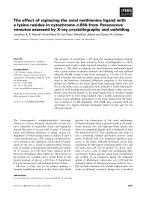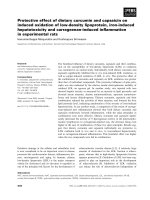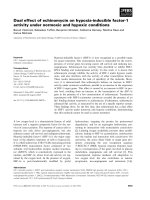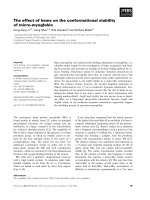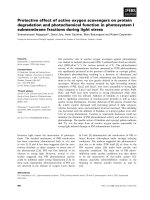Báo cáo khoa học: "Therapeutic effect of bee venom in sows with hypogalactia syndrome postpartum" pptx
Bạn đang xem bản rút gọn của tài liệu. Xem và tải ngay bản đầy đủ của tài liệu tại đây (72.32 KB, 4 trang )
-2851$/ 2)
9HWHULQDU\
6FLHQFH
J. Vet. Sci. (2001),G2(2), 121–124
Therapeutic effect of bee venom in sows with hypogalactia syndrome
postpartum
Seok-Hwa Choi* and Seong-Soo Kang
Department of Veterinary Surgery, College of Veterinary Medicine and Research Institute of Veterinary Medicine,
Chungbuk National University, Cheongju 361-763, Korea
The objective of this study was to determine the clinco-
therapeutic effect of whole bee venom in hypogalactic
sows postpartum. Sows after parturition were assigned to
treated and nontreated control groups. In the treated
group, 22 sows were bee acupunctured once a day for 3
consecutive days. Honeybees (Apis mellifera L.) for bee
acupuncture were about 15 days after metamorphosis.
One live bee was used to sting the acupoints known as
Yang-ming (ST-18, 1.5 cm lateral to the base of the last 2
pairs of teats) and Jiao-chao (GV-1, at the indentation
between the base of tail and the anus). In the control
group, 20 sows were intramuscularly injected with a
standard dosage of penicillin G (400,000 IU/head) once a
day for 3 consecutive days. At post-treatment, 85.0% of
the drug-treated control and 90.9% of the bee venom-
treated group recovered from hypogalactia syndrome.
The advantages of apitherapy were that the patients did
not have stress because they were not restrained for a long
period. The result suggested that apitherapy using bee
venom is an effective treatment for sows with hypogalactia
syndrome postpartum.
Key words:
Apitherapy, bee venom, hypogalactia, sow
Introduction
Since ancient times people have speculated about
honey’s curative properties. The ancient Greeks, Romans,
Chinese and Egyptians used honey to heal wounds and to
cure gut disease [25].
Apitherapy involves the medicinal use of honeybee
products, and it is as old as beekeeping itself. Hippocrates
wrote about it, and there is mention of it in Chinese texts
that are 2,000 years old [2]. Apitherapy began as a part of
folk medicine, and even today, most of the people using it
is therapy either do it themselves or do so with the help of
lay practitioners who administer the live bee sting.
Furthermore, honeybee venom has been domesticated and
a number of its antimicrobial peptides have been isolated,
making it the one used most often for treatment.
Acupuncture, moxa, point bleeding and massage proved
to be effective within a few days in cases of acute mastitis,
breast abscess, and breast carbuncle in women [7,12,24].
Acupuncture cured mammary fibrocystic disease in
women within 3 weeks and can be used in the differential
diagnosis of fibrocystic disease from mammary carcinoma
[3]. Acupuncture was also effective in mammary
hyperplasia [9], and primary agalactia and hypogalactia
[5].
This study was undertaken to determine the therapeutic
effect of bee venom by administering of whole bee venom
to acupuncture points in sows with hypogalactic syndrome
postpartum.
Materials and Methods
A total of 42 cases of sows with hypogalactia syndrome
postpartum were treated over the period of seven months in
1998. Sows with hypogalactia syndrome postpartum were
selected for the study from local rearing farms. Clinical
symptoms were recorded and animals were allocated to
one of two treatment groups.
Sows with hypogalactia syndrome postpartum were
randomly assigned to control and treatment groups. Both
acupoints of Yang-ming (ST-18, 1.5 cm lateral to the base
of the last 2 pairs of teats) and Jiao-chao (GV-1, at the
indentation between the base of tail and the anus) were
chosen for the bee sting (Fig. 1). In the treated group, 22
sows were bee-acupunctured on both acupoints once a day
for 3 consecutive days. In the control group, 20 sows were
intramuscularly injected with a standard dosage of
penicillin G (Green-Cross Vet Pharm Co., 400,000 IU/
head) once a day for 3 consecutive days.
Whole honeybees used for apitherapy in this study were
raised at the farm of the Agricultural College of Chungbuk
National University. Bees of about 15 days old after
*Corresponding author
Phone: +82-43-261-3144; Fax: +82-43-261-3224
E-mail:
122 Seok-Hwa Choi and Seong-Soo Kang
metamorphosis were used, since they are known to have
about 0.1 mg of bee venom in their poison sacs, a strong
bee sting, and are easy to acupuncture.
Clinical findings of rectal temperature, milky discharge
and udder hardening were observed during and after the
treatments. Bacteria of the mammary gland in healthy and
hypogalactic sows were detected using an auto
microorganism analyzer (bioMerieux Vitek, WSVTK-
RO5.04, USA ).
All results are expressed as mean ± SD, and were
analyzed using one-way analysis of variance (ANOVA).
The significance of differences was tested using the paired
Student’s t-test. The criterion for significance was p<0.05.
Results
The criteria for hypogalactia syndrome postpartum in
sows are swelling and hardening of one or several udder
glands with insufficient milk production. Rectal
temperature and udder changes were also observed during
the experimental period. Veterinarians performed a careful
examination of affected animals with a rectal temperature
exceeding 39.3
o
C within 48 hours of farrowing. The rectal
temperature of the affected sows was slightly higher than
that of healthy sows postpartum (Fig. 2). The period of
milky discharge was significantly shorter for bee venom
treated animals than for those receiving drug treatment
(Fig. 3, p<0.05).
Among the several bacteria identified, Escherichia coli,
Strptococcus spp. and Staphylococcus spp. were
predominantly isolated (Table 1). The bacteria were
isolated as pure and as mixed cultures from the mammary
glands.
Post-treatment, 85.0% of the drug-treated control sows
and 90.9% of bee venom-treated sows recovered from
hypogalactia syndrome postpartum (Table 2). Moreover,
the bee acupunctured sows did not show any side effects,
such as infection, bleeding or intoxication.
Discussion
Hypogalactic syndrome postpartum occurs more or less
in all sow herds. Sows with hypogalactic syndrome are a
source of economic loss to the swine industry. Affected
sows show swelling and hardening of one or several udder
glands, and insufficient milk production. In healthy sows,
milk ejection usually starts within <30 seconds after the
initiation of nursing behavior and is of short duration (<30
seconds). The primary clinical signs of periparturient
hypogalactia syndrome (PHS) concern the sow's inability
to produce sufficient milk [10,13] to meet the nutritional
requirements of the piglets. The PHS is observed almost
exclusively within the first 3 days postpartum, with more
than 50% of the affected sows showing clinical signs of
insufficient milk production within 24 hours postpartum
[10]. PHS is only rarely observed more than 72 hours
postpartum [10,16].
Fig. 1. Two local acupoints for bee acupuncture in sows with
hypogalactia syndrome postpartum. C Yang-ming (ST-18, 1.5
cm lateral to the base of the last 2 pairs of teats), D Jiao-chao
(GV-1, at the indentation between the base of the tail and the
anus).
Fig. 2. Changes of rectal temperature in healthy and hypogalactic
sows postpartum.
Fig. 3. Changes of milky discharge and udder hardening in sows
with hypogalactia syndrome by penicillin- and bee venom-
treatment. *p<0.05.
Therapeutic effect of bee venom in sows with hypogalactia syndrome postpartum 123
There is good evidence that milk production in sows is
decreased by several causes [21]. This multiplicity of
etiologies is reflected in the names that have been
associated with this disease complex: coliform mastitis,
PHS, agalactia toxemia, puerperal mastitis, dysgalactia,
mastitis-metritis-agalactia (MMA) syndrome, and
puerperal toxemia [1,16,19,21,23]. While most sows show
decreased milk production, only infrequently is there true
agalactia. Likewise, metritis is rarely part of the syndrome.
PHS more accurately describes the problem [21].
Our results and those of Hermanson et al [10] show an
increase in rectal temperature of 1.0-1.5
o
C in affected
animals. However, the rectal temperature of clinically
normal sows is increased during the first 1-2 days
following parturition. When examined at 1 day prior to
parturition, rectal temperature was found to be both
unchanged [6] and increased [8,18].
The mammary glands of PHS animals may vary in
appearance from normal or firm and locally warm to the
touch to grossly swollen with a blotched appearance [11].
Milk samples collected from affected sows were serous or
creamy and contained fibrin and blood. These clinical
signs are very similar to those reported by Penny [16],
Bertschinger and Pohlenz [1], and Ross et al [20].
De Passille and Rushen [4] demonstrated that in some
cases the clinical presentation may be different, with only
the piglets affected. In this case, the sow is clinically
normal, yet the piglets do not grow at the expected rate due
to excessive teat fighting or neonatal diarrheas. The
majority of sows with hypogalactia were anorectic,
constipated, or depressed as mentioned by Hermanson et
al. [10] and Bertschinger and Pohlenz [1].
Lactation insufficiency in the sow is an extremely
complex syndrome, and over 30 different etiologies have
been associated the problem. Gram-positive bacteria were
identified in a high percentage of affected sows and were
the most important cause of sows with agalactia [17,20].
Oren and Shai [15] were reported that an affected sow,
attributed to bacteria of the genera Escherichia coli,
Staphylococcus spp. and Sterptococcus spp. treated with
bee venom melittin, showed complete lysis of both Gram-
positive and Gram-negative bacteria, as revealed by
transmission electron microscopy.
Honeybee venom contains at least 18 active substances.
Mellitin, the most prevalent, is one of most potent anti-
inflammatory agents known (100 times more potent than
hydrocortisol). Adolapin is another strong anti-
inflammatory substance, and inhibit cyclooxidase. Apamin
inhibits complement C3 activity, and blocks calcium-
dependent potassium channels, thus enhancing nerve
transmission. Other substances, such as Compound X,
hyaluronidase, phospholipase A2, histamine, and mast cell
degeneration protein, are also involved in the inflammatory
response of the venom, in during a softening of tissue and
the facilitation of fluid flow. The mode of action of the bee
venom, melittin, is considered to be via pore formation in
the bacterial membrane, thus influencing the permeability
of translocation, but details have not yet been clarified
[14].
In summary, the advantages of apitherapy were, that
patients did not have to be restrained for a long period, and
that client acceptance was high, as the owners were
accustomed to seeing their animals receive routine
injections. Bee venom has antibacterial activity and is
effective in controlling of hypogalactia in sows.
Acknowledgment
This research was funded by SGRP/PTDP (Problem-
Oriented Technology Development Project for Agriculture
and Forestry) in Korea.
References
1.
Bertschinger, H. U. and Pohlenz, J.
Coliform mastitis. In:
Diseases of Swine, 5th ed. A.D. Leman, R.D. Glock, W.L.
Mengeling, R.H.C. Penney, E. Scholl, and B. Straw. Ames:
Iwoa State Univ. Press. 1980.
2.
Broadman, J.
Bee venom: The natural curative for arthritis
and rheumatism. G.P. Putnams Sons, New York, 1962.
3.
Chen, G. S.
Acupuncture treatment of breast fibrocystic
disease (abstract). Am. J. Acupunct. 1982,
10
, 272.
4.
De Pasille, A M.B. and Rushen J.
Using early suckling
behavior and weight gain to identify piglets at risk. Can. J.
Anim. Sci. 1989,
69
, 535-544.
5.
Fava, A., Bongiovanni, A. and Frassodati, P.
Acupuncture
treatment of hypogalactia. Am. J. Acupunct. 1982,
10
, 333-
339.
Table 1.
List of bacteria isolated from the mammary glands of
healthy and hypogalactic sows postpartum
Bacteria
Healthy sows
(%)
Hypogalatic sows
(%)
Escherichia coli
11(28.9) 12(28.6)
Streptococcus spp.
07(18.4) 11(26.2)
Staphylococcus spp.
09(23.7) 08(19.0)
Corynebacterium spp.
05(13.2) 04(09.5)
Proteus
03(07.9) 02(v4.8)
Others 03(07.9) 05(11.9)
Total 38(100) 42(100)
Table 2.
Therapeutic effects of penicillin and bee venom in sows
with hypogalactia syndrome
Groups
Incidence
(head)
Recovery
(head)
Cure rates
(%)
Penicillin-treated 20 17 85.0
Bee venom-treated 22 20 90.9
124 Seok-Hwa Choi and Seong-Soo Kang
6.
Furniss, S. J.
Measurement of rectal temperature to predict
Mastitis, metritis and agalactia (MMA) in sows after
farrowing. Prev. Vet. Med. 1987,
5
, 133-139.
7.
Gao, D. K., Su, J. M., Liu, C. A., Wang, Z. Y. and Qin, P.
Efficacy of acupuncturing the jianjing point 393 cases of
acute mastitis. J. Tradit. Chin. Med. 1986,
6
, 19-20.
8.
Goransson, L.
The effect of dietary crude fibre content on
the frequency of postpartum agalactia in the sow. Zentralbl
Veterinarmed A. 1989,
36
, 474-479.
9.
Guo, C. J. and Zhang, W. H.
Effect of acupuncture
treatment in 500 patients of mammary gland hyperplasia. J.
Tradit. Chin. Med. 1988,
8
, 157-160.
10.
Hermansson, I., Einarsson, S., Larsson, K. and
Backstrom, L.
On the agalactia post partum in the sow: A
clinical study. Nord. Vet. Med. 1978,
30
, 465-473.
11.
Jones, J. E. T.
Reflections on post-parturient diseases
associated with lactational failure in sows. Vet. Res. 1971,
89
,
72-77.
12.
Liang, Z. P.
Thirty-two cases of acute mastitis treated with
acupuncture, moxibustion and cupping. J. Tradit. Chin. Med.
1988,
8
, 15-18.
13.
Martin, C. E. and Elmore, R. G.
Agalactia in current
therapy in theriogenology. Ed. D.A. Morrow. Philadelphia:
W.B. Saunders. 1980, 1083-1086.
14.
Matsuzaki, K.
Molecular action mechanisms and membrane
recognition of membrane-acting antimicrobial peptides.
Yakugaku Zassh. 1997,
117
, 253-264.
15.
Oren, Z. and Shai, Y.
Selective lysis of bacteria but not
mammalian cells by diasteromers of melittin: structure-
function study. Biochemistry. 1997,
36
, 1826-1835.
16.
Penny, R. H. C.
The agalactia complex in the sow: A review.
Aust. Vet. J. 1970,
46
, 153-159.
17.
Pejsak, A., Tarasuik, K. and Jochle, W.
Immunoprophylaxis against MMA and/or CM in sows with a
vaccine against urinary tract infections (Urovac). Proc. 11th
Int. Congr. Pig Vet. Soc., Lausanne. 1990, 307.
18.
Persson, A., Pedersen, A. E., Goransson, L. and Kuhl, W.
A long term study of the health status and performance of
sows on different feed allowances during late pregnancy. 1.
Clinical observations, with special reference to agalactia post
partum. Acta. Vet. Scand. 1989,
30
, 9-17.
19.
Ross, R. F.
Agalactia syndrome of sows. In: Current
Veterinary Therapy, Food Animal Practice. Ed. J.L. Howard,
Philadelphia: W.B. Saunders, 1981, 962-965.
20.
Ross, R. F., Orning, A. P., Woods, R. D., Zimmermann B.
J., Cox, D. F. and Harris, D. L.
Bacteriologic study of sow
agalactia. Am. J. Vet. Res. 1981,
42
, 949-955.
21.
Smith, B. B., Martineau, G., Bisaillon, A.
Mammary
glands and lactation problem. In: Diseases of Swine, 7th ed.
Ed. A.D. Leman, B.E. Straw, W.L. Mengeling, S. D'Allaire,
D.J. Taylor. Ames: Iowa State Univ Press. 1992, 48-57.
22.
Smith, B. B.
Pathogenesis and therapeutic management of
lactation failure in the periparturient sow. Comp. Cont. Ed.
Prac. Vet. 1985,
7
, S523-S534.
23.
Thurman, J. C. and Simon, J.
A field study of twelve sows
affected with the MMA syndrome. Vet. Med. Small Anim.
Clin. 1970,
65
, 263-272.
24.
Xiong, X. N.
Moxibustion of point Tanzhong and massage of
point Tianzong in 47 cases of acute mastitis. J. Tradit. Chin.
Med. 1982,
2
, 109-110.
25.
Zumla, A. and Lulat, A.
Honey: a remedy rediscovered. J.
Roy. Soc. Med. 1989,
82
, 384-385.





